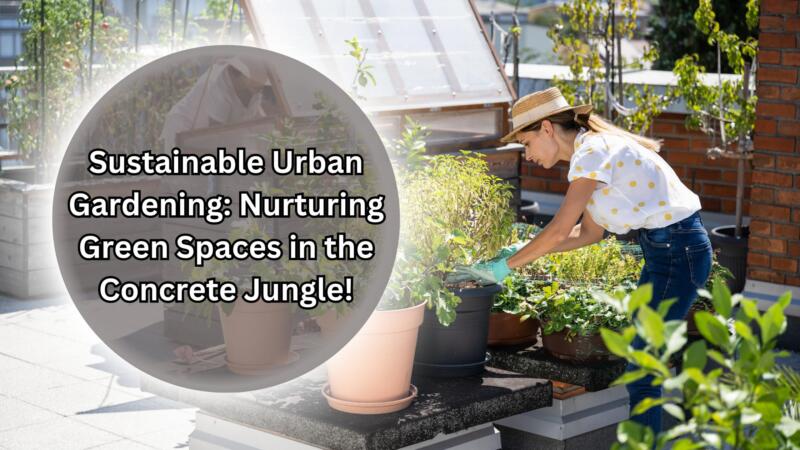Urban living has brought numerous conveniences, but it has also distanced us from the tranquillity of nature. However, the concept of sustainable urban gardening is rapidly gaining momentum, offering a harmonious solution that brings greenery back into our lives while respecting the limitations of city living. In this article, we’ll explore the art of cultivating thriving gardens within urban environments, delve into the benefits it brings, and provide a step-by-step guide for creating your very own sustainable urban garden.
Table of Contents
1. Introduction
- Defining Sustainable Urban Gardening
- Importance of Green Spaces in Urban Settings
2. Benefits of Sustainable Urban Gardening
- Environmental Impact
- Health and Well-being
- Community Building
3. Choosing the Right Plants
- Native Plants vs. Exotics
- Adaptability to Urban Conditions
4. Designing Your Urban Garden
- Vertical Gardens for Limited Space
- Container Gardening on Balconies
5. Soil and Composting
- Enhancing Soil Quality
- Small-Scale Composting Solutions
6. Watering Wisely
- Efficient Irrigation Methods
- Collecting and Reusing Rainwater
7. Managing Pests and Diseases
- Natural Pest Control Measures
- Companion Planting Strategies
8. Promoting Biodiversity
- Creating Mini Ecosystems
- Attracting Pollinators
9. DIY Garden Structures
- Upcycled Planters and Trellises
- Incorporating Recycled Materials
10. Maintenance Routine
- Pruning and Deadheading
- Seasonal Care Guidelines
11. Sustainability Practices
- Using Organic Fertilizers
- Avoiding Harmful Chemicals
12. Community Engagement
- Sharing Produce with Neighbors
- Collaborative Gardening Projects
13. Measuring Success
- Tracking Growth and Yield
- Environmental Impact Assessment
14. Challenges and Solutions
- Limited Sunlight and Shading
- Dealing with Noise and Pollution
15. Conclusion
Introduction
Sustainable urban gardening is more than just a hobby; it’s a movement that seeks to reintroduce nature into our urban landscapes. With cities expanding and green spaces shrinking, the need for creative gardening solutions has never been greater.
Benefits of Sustainable Urban Gardening
The advantages of sustainable urban gardening are multifold. Not only does it bring a touch of lush greenery to the concrete jungle, but it also plays a pivotal role in mitigating environmental challenges, promoting well-being, and fostering a sense of community among residents.
Choosing the Right Plants
Selecting the right plants is crucial for a thriving urban garden. Opting for native plants not only ensures adaptability but also contributes to the local ecosystem’s health. These plants have evolved to thrive in the region’s specific conditions, requiring less maintenance and water.
Designing Your Urban Garden
Limited space is a common challenge in urban settings. Vertical gardens and container gardening offer innovative solutions, allowing you to utilize walls, fences, and balconies to cultivate your green haven.
Soil and Composting
Healthy soil is the foundation of any garden. Enhancing soil quality through composting not only reduces waste but also enriches the soil with essential nutrients, leading to more robust plant growth.
Watering Wisely
Water conservation is paramount in urban gardening. Employing efficient irrigation methods and collecting rainwater for later use are effective ways to ensure your garden thrives without straining the city’s water resources.
Managing Pests and Diseases
Pests and diseases can wreak havoc on urban gardens. Embracing natural pest control approaches and strategically planting companion crops can help manage these issues without resorting to harmful chemicals.
Promoting Biodiversity
Urban gardens can contribute to biodiversity conservation. By creating microhabitats and planting flowers that attract pollinators like bees and butterflies, you can foster a more diverse and resilient ecosystem.
DIY Garden Structures
Incorporate your creativity into the garden by crafting DIY planters, trellises, and other structures using recycled materials. This not only adds aesthetic appeal but also aligns with the principles of sustainability.
Maintenance Routine
Regular maintenance is essential to ensure your urban garden thrives year-round. Pruning, deadheading, and following seasonal care guidelines will keep your plants healthy and vibrant.
Sustainability Practices
Maintain the sustainability of your garden by using organic fertilizers and avoiding synthetic chemicals that could harm the environment. This commitment to eco-friendly practices enhances the overall impact of your garden.
Community Engagement
Sustainable urban gardening can also foster a sense of community. Sharing your garden’s bounty with neighbours and participating in collaborative gardening projects strengthen social bonds and promote the value of locally grown produce.
Measuring Success
Tracking the growth and yield of your garden provides a tangible sense of achievement. Additionally, assessing the environmental benefits your garden brings, such as improved air quality and reduced urban heat, quantifies its positive impact.
Challenges and Solutions
Overcoming challenges like limited sunlight and exposure to pollution requires innovative solutions. Opt for shade-tolerant plants and consider air-purifying species to counteract these issues.
Conclusion
Sustainable urban gardening is an invitation to reconnect with nature amid the bustling urban landscape. By embracing eco-friendly practices and transforming available spaces into green oases, we can collectively contribute to a healthier, more vibrant city environment.
FAQs
Can I start an urban garden if I have limited gardening experience?
Absolutely! Sustainable urban gardening is accessible to beginners and can be a rewarding learning experience.
What are the best plants for a small balcony garden?
Herbs like basil and mint, along with compact veggies like cherry tomatoes, are excellent choices for balcony gardens.
How can I prevent pests without using harmful chemicals?
Natural solutions like introducing beneficial insects and practising companion planting can help deter pests.
Is composting difficult in an urban setting?
Not at all! Small-scale composting using kitchen scraps can quickly be done with minimal space.
What role does community gardening play in urban sustainability?
Community gardens promote green spaces, local food production, and social interactions, enhancing urban sustainability.
